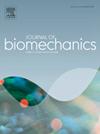Functional data analysis of the full-body kinematics during a step-up task in subjects with and without low back pain: A cross-sectional study
IF 2.4
3区 医学
Q3 BIOPHYSICS
引用次数: 0
Abstract
This study aims to explore comprehensive kinematic patterns of all body joints utilizing a nonlinear functional data analysis (FDA) approach during a step-up task in patients with nonspecific chronic low back pain (NSCLBP). The kinematics of the trunk, pelvis, and upper- and lower-extremities during step-up exercises were assessed in NSCLBP (N = 23) and control (N = 22) groups using a Motion Analysis System. FDA was employed to compare movement-patterns of 15 segments between two groups. In the NSCLBP group, there was a significant decrease in flexion in specific spine regions (upper-thoracic and upper-lumbar segments) and increased flexion in the lower-thoracic-segment and most lower limb joints (except the dominant-knee) during the first phase (swing phase of leading-leg). Throughout the movement-cycle, in frontal-plane, increased adduction and inversion, along with decreased abduction and eversion were found in most lower limb joints (except the non-dominant hip and knee). Furthermore, during the movement-cycle, in transverse-plane, were observed, increased internal-rotation and decreased external-rotation in both hips and dominant knee, increased contralateral-rotation and decreased ipsilateral-rotation (relative to leading-limb) in all spine-segments, and increased forward-rotation in the pelvis. Notably, the upper-limbs showed decreased dominant-shoulder flexion, increased abduction of both shoulders, and increased upward-rotation of the non-dominant scapula throughout the movement-cycle in LBP group. This study revealed compensatory-mechanisms in NSCLBP-patients to counterbalance reduced sagittal-plane movement in specific spine regions, leading to increased motion across various joints in all three-planes, particularly frontal- and transverse-planes. Overall, FDA showed a prevalent pattern of flexion, adduction, and internal-rotation in most segments during step-up task in NSCLBP-patients.
求助全文
约1分钟内获得全文
求助全文
来源期刊

Journal of biomechanics
生物-工程:生物医学
CiteScore
5.10
自引率
4.20%
发文量
345
审稿时长
1 months
期刊介绍:
The Journal of Biomechanics publishes reports of original and substantial findings using the principles of mechanics to explore biological problems. Analytical, as well as experimental papers may be submitted, and the journal accepts original articles, surveys and perspective articles (usually by Editorial invitation only), book reviews and letters to the Editor. The criteria for acceptance of manuscripts include excellence, novelty, significance, clarity, conciseness and interest to the readership.
Papers published in the journal may cover a wide range of topics in biomechanics, including, but not limited to:
-Fundamental Topics - Biomechanics of the musculoskeletal, cardiovascular, and respiratory systems, mechanics of hard and soft tissues, biofluid mechanics, mechanics of prostheses and implant-tissue interfaces, mechanics of cells.
-Cardiovascular and Respiratory Biomechanics - Mechanics of blood-flow, air-flow, mechanics of the soft tissues, flow-tissue or flow-prosthesis interactions.
-Cell Biomechanics - Biomechanic analyses of cells, membranes and sub-cellular structures; the relationship of the mechanical environment to cell and tissue response.
-Dental Biomechanics - Design and analysis of dental tissues and prostheses, mechanics of chewing.
-Functional Tissue Engineering - The role of biomechanical factors in engineered tissue replacements and regenerative medicine.
-Injury Biomechanics - Mechanics of impact and trauma, dynamics of man-machine interaction.
-Molecular Biomechanics - Mechanical analyses of biomolecules.
-Orthopedic Biomechanics - Mechanics of fracture and fracture fixation, mechanics of implants and implant fixation, mechanics of bones and joints, wear of natural and artificial joints.
-Rehabilitation Biomechanics - Analyses of gait, mechanics of prosthetics and orthotics.
-Sports Biomechanics - Mechanical analyses of sports performance.
 求助内容:
求助内容: 应助结果提醒方式:
应助结果提醒方式:


